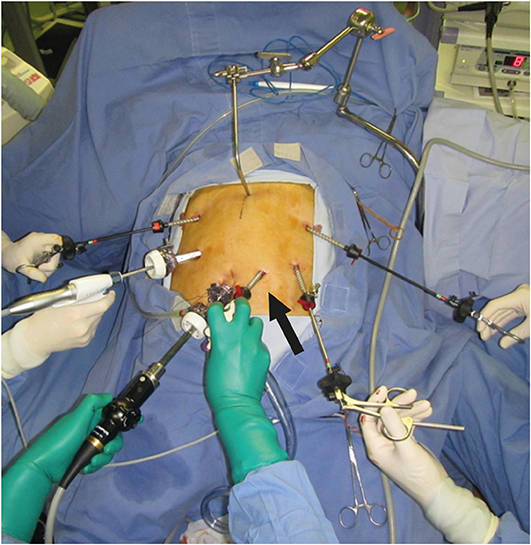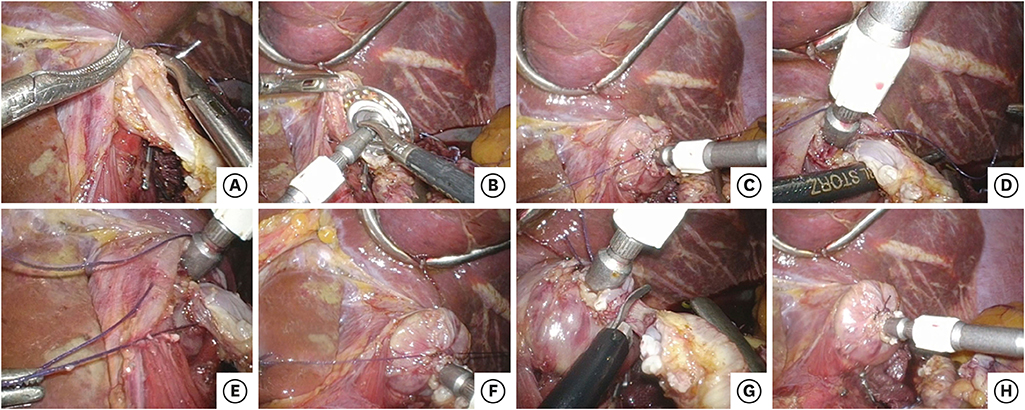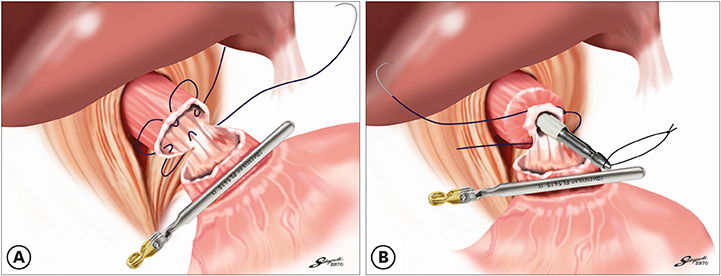J Gastric Cancer.
2019 Sep;19(3):290-300. 10.5230/jgc.2019.19.e26.
A Novel Technique of Hand-Sewn Purse-String Suturing by Double Ligation Method (DLM) for Intracorporeal Circular Esophagojejunostomy
- Affiliations
-
- 1Department of Surgery, Ogaki Municipal Hospital, Ogaki, Japan. t-yuichi@rf6.so-net.ne.jp
- KMID: 2458829
- DOI: http://doi.org/10.5230/jgc.2019.19.e26
Abstract
- PURPOSE
The optimal method for intracorporeal esophagojejunostomy remains unclear because a purse-string suture for fixing the anvil into the esophagus is difficult to perform with a laparoscopic approach. Therefore, this study aimed to evaluate our novel technique to fix the anvil into the esophagus.
MATERIALS AND METHODS
This retrospective study included 202 patients who were treated at our institution with an intracorporeal circular esophagojejunostomy in a laparoscopy-assisted total gastrectomy with a Roux-en-Y reconstruction (166 cases) or a laparoscopy-assisted proximal gastrectomy with jejunal interposition (36 cases). After incising 3/4 of the esophageal wall, a hand-sewn purse-string suture was placed on the esophagus. Next, the anvil head of a circular stapler was introduced into the esophagus. Finally, the circular esophagojejunostomy was performed laparoscopically. The clinical characteristics and surgical outcomes were evaluated and compared with those of other methods.
RESULTS
The average operation time was 200.3 minutes. The average hand-sewn purse-string suturing time was 6.4 minutes. The overall incidence of postoperative complications (Clavien-Dindo classification grade ≥II) was 26%. The number of patients with an anastomotic leakage and stenosis at the esophagojejunostomy site were 4 (2.0%) and 12 (6.0%), respectively. All patients with stenosis were successfully treated by endoscopic balloon dilatation. There was no mortality. Regarding the materials and devices for anvil fixation, only 1 absorbable thread was needed.
CONCLUSIONS
Our procedure for hand-sewn purse-string suturing with the double ligation method is simple and safe.
MeSH Terms
Figure
Reference
-
1. Katai H, Sasako M, Fukuda H, Nakamura K, Hiki N, Saka M, et al. Safety and feasibility of laparoscopy-assisted distal gastrectomy with suprapancreatic nodal dissection for clinical stage I gastric cancer: a multicenter phase II trial (JCOG 0703). Gastric Cancer. 2010; 13:238–244.
Article2. Kitano S, Shiraishi N, Uyama I, Sugihara K, Tanigawa N. Japanese Laparoscopic Surgery Study Group. A multicenter study on oncologic outcome of laparoscopic gastrectomy for early cancer in Japan. Ann Surg. 2007; 245:68–72.
Article3. Fukunaga T, Hiki N, Kubota T, Nunobe S, Tokunaga M, Nohara K, et al. Oncologic outcomes of laparoscopy-assisted distal gastrectomy for gastric cancer. Ann Surg Oncol. 2013; 20:2676–2682.
Article4. Jeong O, Park YK. Intracorporeal circular stapling esophagojejunostomy using the transorally inserted anvil (OrVil) after laparoscopic total gastrectomy. Surg Endosc. 2009; 23:2624–2630.
Article5. Fujimoto S, Takahashi M, Endoh F, Takai M, Kobayashi K, Kiuchi S, et al. Stapled or manual suturing in esophagojejunostomy after total gastrectomy: a comparison of outcome in 379 patients. Am J Surg. 1991; 162:256–259.
Article6. Hiki N, Fukunaga T, Yamaguchi T, Nunobe S, Tokunaga M, Ohyama S, et al. Laparoscopic esophagogastric circular stapled anastomosis: a modified technique to protect the esophagus. Gastric Cancer. 2007; 10:181–186.
Article7. Usui S, Nagai K, Hiranuma S, Takiguchi N, Matsumoto A, Sanada K. Laparoscopy-assisted esophagoenteral anastomosis using endoscopic purse-string suture instrument “Endo-PSI (II)” and circular stapler. Gastric Cancer. 2008; 11:233–237.
Article8. Omori T, Oyama T, Mizutani S, Tori M, Nakajima K, Akamatsu H, et al. A simple and safe technique for esophagojejunostomy using the hemidouble stapling technique in laparoscopy-assisted total gastrectomy. Am J Surg. 2009; 197:e13–e17.
Article9. Okabe H, Obama K, Tanaka E, Nomura A, Kawamura J, Nagayama S, et al. Intracorporeal esophagojejunal anastomosis after laparoscopic total gastrectomy for patients with gastric cancer. Surg Endosc. 2009; 23:2167–2171.
Article10. Inaba K, Satoh S, Ishida Y, Taniguchi K, Isogaki J, Kanaya S, et al. Overlap method: novel intracorporeal esophagojejunostomy after laparoscopic total gastrectomy. J Am Coll Surg. 2010; 211:e25–e29.
Article11. Japanese Gastric Cancer Association. Japanese classification of gastric carcinoma: 3rd English edition. Gastric Cancer. 2011; 14:101–112.12. Takayama Y, Kaneoka Y, Maeda A, Fukami Y, Onoe S. Comparison of outcomes of laparoscopy-assisted and open proximal gastrectomy with jejunal interposition for early gastric cancer in the upper third of the stomach: a retrospective observational study. Asian J Endosc Surg. 2018; 11:329–336.
Article13. Dindo D, Demartines N, Clavien PA. Classification of surgical complications: a new proposal with evaluation in a cohort of 6336 patients and results of a survey. Ann Surg. 2004; 240:205–213.14. Takayama Y, Kaneoka Y, Maeda A, Fukami Y, Onoe S. Extracorporeal hand-sewn anastomosis through a minilaparotomy in laparoscopic distal gastrectomy. J Laparoendosc Adv Surg Tech A. 2017; 27:726–732.
Article15. Kunisaki C, Makino H, Oshima T, Fujii S, Kimura J, Takagawa R, et al. Application of the transorally inserted anvil (OrVil) after laparoscopy-assisted total gastrectomy. Surg Endosc. 2011; 25:1300–1305.
Article16. Nunobe S, Hiki N, Tanimura S, Kubota T, Kumagai K, Sano T, et al. Three-step esophagojejunal anastomosis with atraumatic anvil insertion technique after laparoscopic total gastrectomy. J Gastrointest Surg. 2011; 15:1520–1525.
Article17. Ito H, Inoue H, Odaka N, Satodate H, Onimaru M, Ikeda H, et al. Evaluation of the safety and efficacy of esophagojejunostomy after totally laparoscopic total gastrectomy using a trans-orally inserted anvil: a single-center comparative study. Surg Endosc. 2014; 28:1929–1935.
Article18. Kawamura H, Ohno Y, Ichikawa N, Yoshida T, Homma S, Takahashi M, et al. Anastomotic complications after laparoscopic total gastrectomy with esophagojejunostomy constructed by circular stapler (OrVil™) versus linear stapler (overlap method). Surg Endosc. 2017; 31:5175–5182.
Article19. Wada N, Kurokawa Y, Takiguchi S, Takahashi T, Yamasaki M, Miyata H, et al. Feasibility of laparoscopy-assisted total gastrectomy in patients with clinical stage I gastric cancer. Gastric Cancer. 2014; 17:137–140.
Article20. Kinoshita T, Oshiro T, Ito K, Shibasaki H, Okazumi S, Katoh R. Intracorporeal circular-stapled esophagojejunostomy using hand-sewn purse-string suture after laparoscopic total gastrectomy. Surg Endosc. 2010; 24:2908–2912.
Article21. Lee MS, Lee JH, Park DJ, Lee HJ, Kim HH, Yang HK. Comparison of short- and long-term outcomes of laparoscopic-assisted total gastrectomy and open total gastrectomy in gastric cancer patients. Surg Endosc. 2013; 27:2598–2605.
Article22. Liu W, Guo Y, Qiu Z, Niu D, Zhang J. Intracorporeal circular stapled esophagojejunostomy using conventional purse-string suture instrument after laparoscopic total gastrectomy. J Laparoendosc Adv Surg Tech A. 2017; 27:1299–1304.
Article23. Sugiyama M, Oki E, Ogaki K, Morita M, Sakaguchi Y, Koga S, et al. Clinical outcomes of esophagojejunostomy in totally laparoscopic total gastrectomy: a multicenter study. Surg Laparosc Endosc Percutan Tech. 2017; 27:e87–e91.
Article24. Kim HI, Cho I, Jang DS, Hyung WJ. Intracorporeal esophagojejunostomy using a circular stapler with a new purse-string suture technique during laparoscopic total gastrectomy. J Am Coll Surg. 2013; 216:e11–e16.
Article25. Du J, Shuang J, Li J, Li J, Hua J. Intracorporeal circular-stapled esophagojejunostomy after laparoscopic total gastrectomy: a novel self-pulling and holding purse-string suture technique. J Am Coll Surg. 2014; 218:e67–e72.
Article26. Umemura A, Koeda K, Sasaki A, Fujiwara H, Kimura Y, Iwaya T, et al. Totally laparoscopic total gastrectomy for gastric cancer: literature review and comparison of the procedure of esophagojejunostomy. Asian J Surg. 2015; 38:102–112.
Article27. Kyogoku N, Ebihara Y, Shichinohe T, Nakamura F, Murakawa K, Morita T, et al. Circular versus linear stapling in esophagojejunostomy after laparoscopic total gastrectomy for gastric cancer: a propensity score-matched study. Langenbecks Arch Surg. 2018; 403:463–471.
Article28. Zuiki T, Hosoya Y, Kaneda Y, Kurashina K, Saito S, Ui T, et al. Stenosis after use of the double-stapling technique for reconstruction after laparoscopy-assisted total gastrectomy. Surg Endosc. 2013; 27:3683–3689.
Article29. Kosuga T, Hiki N, Nunobe S, Ohashi M, Kubota T, Kamiya S, et al. Does the single-stapling technique for circular-stapled esophagojejunostomy reduce anastomotic complications after laparoscopic total gastrectomy? Ann Surg Oncol. 2015; 22:3606–3612.
Article30. Katai H, Morita S, Saka M, Taniguchi H, Fukagawa T. Long-term outcome after proximal gastrectomy with jejunal interposition for suspected early cancer in the upper third of the stomach. Br J Surg. 2010; 97:558–562.
Article
- Full Text Links
- Actions
-
Cited
- CITED
-
- Close
- Share
- Similar articles
-
- Intrathoracic anastomosis using handsewn purse-string suturing by the double-ligation method in laparo-thoracoscopic esophagectomy
- Immediate Umbilical Reconstruction after Removal of Umbilicus due to Urachal Cancer: Defatting, Anchoring and Purse-String Suture
- Totally Laparoscopic Total Gastrectomy Using Intracorporeally Hand-Sewn Esophagojejunostomy
- Optimal anastomotic technique in rectal surgery to prevent anastomotic leakage
- Treatment of Benign Tumors by Excision Using Purse-String Suture




